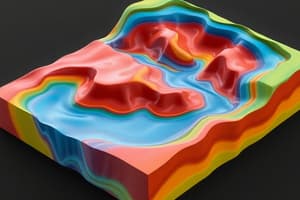Podcast
Questions and Answers
Wireline logs and MWD/LWD logs provide continuous records of accurate information on stratigraphic surfaces and petrophysical properties.
Wireline logs and MWD/LWD logs provide continuous records of accurate information on stratigraphic surfaces and petrophysical properties.
True (A)
The Composite log integrates geological columnar sections with a single petrophysical log.
The Composite log integrates geological columnar sections with a single petrophysical log.
False (B)
CPI logs are solely evaluated manually without the use of computers.
CPI logs are solely evaluated manually without the use of computers.
False (B)
Mathematical, statistical, and numerical techniques are essential for well-log data processing and interpretation.
Mathematical, statistical, and numerical techniques are essential for well-log data processing and interpretation.
The primary source for reservoir property data is derived from petrophysical interpretation of porosity and water saturation.
The primary source for reservoir property data is derived from petrophysical interpretation of porosity and water saturation.
Static data in reservoir modelling includes pressure and fluid production observed at wells.
Static data in reservoir modelling includes pressure and fluid production observed at wells.
Integrating dynamic data with static data improves accuracy in predictions of reservoir models.
Integrating dynamic data with static data improves accuracy in predictions of reservoir models.
Intermediate surfaces in a reservoir model help define its internal stratigraphic architecture.
Intermediate surfaces in a reservoir model help define its internal stratigraphic architecture.
Faults are disregarded in reservoir modelling when analysing fluid flow.
Faults are disregarded in reservoir modelling when analysing fluid flow.
Inconsistencies in input data during modelling will not affect the final results or intermediate steps.
Inconsistencies in input data during modelling will not affect the final results or intermediate steps.
Dynamic data used in reservoir modelling can change over time.
Dynamic data used in reservoir modelling can change over time.
Quality of input data is a secondary concern in reservoir modelling projects.
Quality of input data is a secondary concern in reservoir modelling projects.
The geometry of a reservoir model is defined using a polygon to show the lateral extension of the model.
The geometry of a reservoir model is defined using a polygon to show the lateral extension of the model.
Well data represents a small investigation volume for the reservoir being modelled.
Well data represents a small investigation volume for the reservoir being modelled.
Seismic data provide detailed measurements of small-scale reservoir characteristics.
Seismic data provide detailed measurements of small-scale reservoir characteristics.
Core derived data can provide information about sedimentology and petrophysical properties.
Core derived data can provide information about sedimentology and petrophysical properties.
Dynamic data is derived solely from seismic surveys.
Dynamic data is derived solely from seismic surveys.
The Kick-off Point (KOP) is the depth at which a well is first straightened from the vertical.
The Kick-off Point (KOP) is the depth at which a well is first straightened from the vertical.
Directional drilling is used to create wells with very steep inclinations, specifically over 85°.
Directional drilling is used to create wells with very steep inclinations, specifically over 85°.
The total depth (TD) of a well indicates how far the well extends vertically.
The total depth (TD) of a well indicates how far the well extends vertically.
Vertical wells are typically defined as those with an inclination over 10°.
Vertical wells are typically defined as those with an inclination over 10°.
Flashcards
Wireline Logs and MWD/LWD Logs
Wireline Logs and MWD/LWD Logs
Continuous, high-resolution records providing information about geological layers, their properties like porosity (φ) and permeability (k), and facies types.
Composite Log
Composite Log
A graphical log that integrates the geological columnar section with significant petrophysical logs, like lithology, porosity, and resistivity logs.
Petrophysical Logs
Petrophysical Logs
Primary logs containing basic measurements from the wellbore, including well header data and primary logs.
Basic Input Data for Reservoir Modeling
Basic Input Data for Reservoir Modeling
Signup and view all the flashcards
Computer-Processed Interpretation (CPI) Logs
Computer-Processed Interpretation (CPI) Logs
Signup and view all the flashcards
Well Data
Well Data
Signup and view all the flashcards
Core Data
Core Data
Signup and view all the flashcards
Wellbore Path
Wellbore Path
Signup and view all the flashcards
Directional Drilling
Directional Drilling
Signup and view all the flashcards
Vertical Wells
Vertical Wells
Signup and view all the flashcards
Horizontal Wells
Horizontal Wells
Signup and view all the flashcards
Kick-off Point (KOP)
Kick-off Point (KOP)
Signup and view all the flashcards
End of Build-up Point (EOB)
End of Build-up Point (EOB)
Signup and view all the flashcards
What are the two main data types used in reservoir modeling?
What are the two main data types used in reservoir modeling?
Signup and view all the flashcards
What is static data in reservoir modeling?
What is static data in reservoir modeling?
Signup and view all the flashcards
What is dynamic data in reservoir modeling?
What is dynamic data in reservoir modeling?
Signup and view all the flashcards
Why is data integration important for reservoir modeling?
Why is data integration important for reservoir modeling?
Signup and view all the flashcards
What data is needed to define the geometry of a reservoir model?
What data is needed to define the geometry of a reservoir model?
Signup and view all the flashcards
How are faults incorporated in reservoir modeling?
How are faults incorporated in reservoir modeling?
Signup and view all the flashcards
Where does the data for petrophysical properties in a reservoir model come from?
Where does the data for petrophysical properties in a reservoir model come from?
Signup and view all the flashcards
Why is data management crucial for reservoir modeling?
Why is data management crucial for reservoir modeling?
Signup and view all the flashcards
Study Notes
Reservoir Modelling: Input Data
-
Reservoir modeling uses two main types of data:
- Static data (e.g., core samples, well logs, seismic interpretations)
- Dynamic data (e.g., pressure, fluid production observed at wells)
-
Integrating both static and dynamic data improves reservoir model quality.
-
Data integration benefits reservoir engineers. This allows better reservoir simulation and management.
Importance of Data Integration
- Increased accuracy in predictions
- Enhanced risk assessment
- Improved decision making in resource management
Reservoir Model Geometry Data
- Reservoir model geometry is defined by polygons specifying the lateral extent of the model.
- The model's top and base surfaces define the vertical positions and thickness of the reservoir.
- Intermediate surfaces are sometimes needed to define internal stratigraphic architecture.
- These surfaces can come from seismic interpretations or mapping formation markers from wells and stratigraphic correlations.
Fault Data
- Faults influencing fluid flow are essential inputs for defining faulted model frameworks.
- Fault information is often obtained from seismic interpretations.
Petrophysical Property Data
- Petrophysical properties model data, such as properties, are usually obtained from petrophysical analysis of well logs and cores.
Dynamic Data
- Dynamic data changes over time.
- Examples: pressures, liquid and gas production rates can be used to model a reservoir.
Data Collection & Management
- Data management is crucial for modeling projects.
- The quality of input data directly impacts the final results.
- Inconsistencies in input data will become apparent during intermediate modeling steps.
Primary Data Types
- Well data: direct sampling from cores, indirect measurements from logs (facies and fluids), and modern image logs.
- Seismic data: provides information on large-scale reservoir geometry.
- Dynamic data: from well tests, historical production figures.
Well Data: Core Data
- Core plugs or entire core sections are used.
- This data provides detailed information about:
- Sedimentology
- Petrography
- Depositional environments
- Porosity
- Permeability
- Grain density
- Fluid shows
- Petrophysical core-to-log calibration
Well Data: Wellbore Path
-
Wellbore path data is calculated from survey data.
-
The data is stored in the database.
-
The data illustrates the trajectory of the well in 3D space.
-
Essential components:
- Directional coordinates
- True vertical depth (TVD)
- Total depth (TD)
- Kick-off point (KOP)
- End of Build-up point (EOB) / Landing point
Well Logs and MWD/LWD Logs
- Continuous, high-resolution records of information.
- Facies types, stratigraphic surfaces, and measurements of petrophysical properties.
- Recorded data can be graphical logs including primary measurements such as well header data.
- Composite logs integrate geological columnar section with selected petrophysical values.
Computer-Processed Interpretation (CPI) Logs
- Geological zone lithology, porosity, and resistivity logs.
- Pre-processed for modelling.
- Can be plotted and displayed as curves. ('basic input data').
- Processed logs are stored as input data for reservoir modeling.
Well Log Data Processing and Interpretation
- Involves mathematical, statistical, and numerical techniques.
- Can be carried out manual or by using computer
- Data quality is important for the end results
- Petrophysical interpretations of porosity and water saturation are fundamental sources for reservoir properties data.
Studying That Suits You
Use AI to generate personalized quizzes and flashcards to suit your learning preferences.



